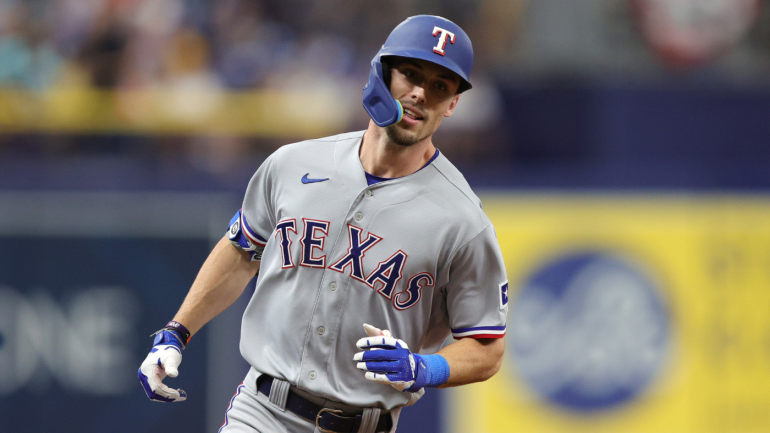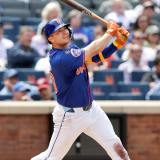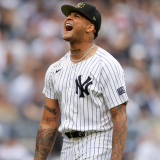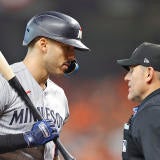
For the third time in franchise history, the Texas Rangers are American League champions. The Rangers ousted the defending World Series champion Houston Astros in Game 7 of the Championship Series on Monday, and will take on either the Arizona Diamondbacks or Philadelphia Phillies when the World Series begins Friday at Globe Life Field.
"I'll be honest. I don't think about me. I'm riding their backs, trust me," Rangers manager Bruce Bochy said after clinching the pennant. "This team, as I said, it's been an honor to watch them. And so it's great to be here. It's unreal that I'm here, to be honest. Sitting at the house for three years, and think here I am going to a World Series. Yeah, that's special. But it's more about them and trying to find a way to get a ring for those guys."
Two years ago, the Rangers lost 102 games and were a last-place team. Their remarkable turnaround began with the Corey Seager and Marcus Semien signings -- $500 million committed to two middle infielders -- and continued with trades for Dane Dunning, Mitch Garver, Jonah Heim, and Nathaniel Lowe. Homegrown players like Josh Jung and Leody Taveras were called up too.
There was also a little luck sprinkled in as well. None of the other 29 teams claimed star slugger Adolis García when the Rangers placed him on waivers in February 2021. García cleared waivers, remained with the Rangers, and eventually made his way back to the big leagues later that year. Since then he's gone to two All-Star Games, hit 97 home runs, and win ALCS MVP.
The Rangers went for the kill last offseason when they signed Jacob deGrom and Nathan Eovaldi, and lured Bochy, a future Hall of Famer, out of retirement. Things rarely go according to plan in this game though -- deGrom made six starts before requiring his second career Tommy John surgery -- and the Rangers had to make adjustments on the fly this season. Here are four in-season moves that helped Texas get to the World Series.
July 30: The Montgomery trade
These moves are listed chronologically but it is only fitting we begin with the most impactful move of the 2023 trade deadline. Two days before the deadline, the Rangers acquired left-hander Jordan Montgomery from the St. Louis Cardinals in a five-player deal. Montgomery and reliever Chris Stratton went to Texas for reliever John King and prospects Tekoah Roby and Thomas Saggese.
"We had an opportunity to acquire another starting pitcher and a veteran reliever that we think will both help us," GM Chris Young told MLB.com after the trade. "Jordan Montgomery is having a tremendous year. We felt like he was one of the better starters on the market. And given where we are, that we needed to continue to upgrade our rotation. We addressed that."
The Rangers also brought in Max Scherzer at the deadline; they needed two starters because deGrom and Eovaldi got hurt over the summer, and because Martín Pérez was in the middle of pitching his way to the bullpen. Texas was still in first place at the time, but their AL West lead was dwindling, and the cracks in the dam were growing. They needed helped.
Think about this: deGrom and Eovaldi got hurt, so Texas traded for Montgomery and Scherzer. They didn't get cute. They went out and got the best both last winter and at the deadline. The Rangers operated with an urgency you didn't see from, say, the Seattle Mariners, who Texas beat out for the third wild-card spot, or the Baltimore Orioles, who they swept in the Division Series.
Montgomery was terrific after the trade, pitching to a 2.79 ERA while averaging just over six innings in his 11 starts. He's been even better in October, putting up a 2.16 ERA in 25 innings spread across four starts and one relief appearance. That one relief appearance came on two days' rest in Game 7 of the ALCS, and really settled that game down for Texas.
In Montgomery, the Rangers essentially acquired an ace. He's performed at that level since coming over, both in the regular season and postseason. Does Young go out and get him if deGrom and Eovaldi avoid injury? Maybe, maybe not. You can never have too much pitching, after all. Either way, Montgomery has become one of the greatest deadline acquisitions in recent baseball history.
"They've worked together before, and so there's a sense of confidence that Jordan has with Mike," Rangers manager Bruce Bochy said about Montgomery and pitching coach Mike Maddux, who were together with the Cardinals last season. "The game planning, things like that. They're so prepared. That's always nice to have, you make a trade or something, it makes the transition so much easier. So from day one he's been very comfortable here."
Mid August: Smith demoted out of closer's role
For the first four months of the season, veteran left-hander Will Smith was a rock at the back of the bullpen, going 17 for 19 in save chances and pitching to a 2.84 ERA in 38 innings through July. Bochy and Smith were together with the San Francisco Giants from 2016-19, so there was familiarity and comfort there. Smith was proving to be a bargain on his one-year, $1.5 million contract.
Smith as the closer worked until suddenly it didn't. The wheels came off in August and at one point Smith allowed 12 runs in 6 1/3 innings spanning eight appearances. Bochy had no choice but to demote him out of the closer's role. Aroldis Chapman, who the Rangers acquired in late June, was given a crack at the job, but he was shaky too. Soon thereafter the Rangers blew a three-run lead in three straight games.
The bullpen had been a headache all season for the Rangers and it only got worse after Smith had to be removed from the closer's role. It really wasn't until the postseason that José Leclerc, who was working lower leverage innings as recently as July, grabbed the job and ran with it. He did begin to see more responsibility in August and September, however.
Leverage index, which measures the importance of the game situation, tells a story. Here are the average leverage index numbers when entering the game for Chapman, Leclerc, and Smith throughout the season (Chapman's time with Texas only). A leverage index of 1.00 is average and the smaller the number, the lower the leverage. The higher the number, the higher the leverage.
| Smith | Chapman | Leclerc | |
|---|---|---|---|
April | 1.87 | -- | 1.57 |
May | 1.94 | -- | 0.78 |
June | 1.47 | -- | 0.52 |
July | 1.23 | 1.23 | 0.77 |
August | 2.09 | 1.85 | 1.24 |
September | 1.30 | 1.72 | 1.57 |
The typical closer will see an average leverage index in the 1.90 range and Smith was there most of the season. Leclerc, on the other hand, began the year in a higher leverage role, got demoted, then regained Bochy's trust in September. I mean, a leverage index in the 0.52 range is mop up-man territory. That's the score reserved for the last guy in the bullpen.
Jose Altuve's ALCS Game 5 home run aside, Leclerc has been fantastic this postseason, allowing only two runs in his other nine appearances. Smith is more or less out of the picture -- he's appeared in three games and faced only 10 batters in October -- and Chapman is no longer trusted, it seems. Bochy did not use him in the must-win Game 6 with a small lead.
The Texas bullpen is still pretty sketchy, don't get me wrong, but it's better that Smith melted down in August and not later in the season. That gave Bochy and the Rangers time to adjust, and it gave Leclerc an opportunity to earn more responsibility. He has been Bochy's go-to reliever since September and has helped stabilize the ninth inning in October.
Sept. 8: Carter called up
On Sept. 8, the Rangers placed García on the 10-day injured list with right patellar tendon strain. They'd lost three straight games and 15 of their last 19 games, and fallen out of first place. Texas badly needed a spark, so, to replace García, they called up top prospect Evan Carter. The 21-year-old slashed .288/.413/.450 at three minor-league levels in 2023.
"(García's) injury aside, Evan has performed at both Double-A and Triple-A this year," Young told MLB.com after Carter was promoted. "He has an elite approach, strike zone awareness and control, and really fits the profile of a player that we think can have success at the Major League level. We also recognize that Evan is still developing and there's a learning curve. This will be the best pitching he's ever faced in the Major Leagues and he's coming into a pennant race. I don't want any unfair expectations for Evan, but we're very, very excited to add him to our roster. We're very optimistic and excited about his future and we think he makes the Texas Rangers better, both now and in the future. We're excited for his debut."
Carter made an instant impact. He singled in his first big-league at-bat, went deep in his third big-league start, and hit .306/.413/.645 with five home runs in 23 games in September. Carter's been even better in the postseason: .308/.449/.538 with nearly as many walks (nine) as strikeouts (11) in 12 games against the best pitching he's ever faced in the most pressure-packed environments he's ever played. He's taken over as the club's regular No. 3 hitter between Seager and García.
"We needed the help, so no question that had a lot with Carter getting called up," Bochy said after Game 7. "We needed some help. We needed a shot in the arm with this offense, a guy that can get on base, speed, defense. Nothing against the other guys, but, yeah, sure, that had something to do with a young kid like this getting called up."
For much of the season, the Rangers cycled through Ezequiel Duran, Robbie Grossman, Travis Jankowski, and a few others in left field. Basically, whoever was hitting well at any given moment was the starting left fielder. Carter settled the position and performed at a very high level, and stayed in the lineup once García returned after the minimum 10 days on the injured list. In Montgomery, the Rangers added someone who's pitched like an ace. In Carter, the Rangers called up someone who's hit like an MVP.
"I could see this in the kid in Spring Training, the calmness and confidence that he plays with," Bochy added. "We put him in the nine-hole, and he was doing a great job of turning the lineup over. Then we put him in the five-hole, didn't faze him. Then we put him in the three-hole, that didn't faze him. This kid has a nice career ahead of him. For a 21-year-old to be in the three-hole and handle it the way he has, it says a lot about his makeup."
Sept. 27: Sborz activated
With all due respect to Leclerc, Josh Sborz has been the Rangers' best reliever this postseason. The 29-year-old has appeared in eight of the team's 12 postseason games, including five of the seven ALCS games, and he's allowed just one run in 8 2/3 innings. This came after a 5.50 ERA in 52 1/3 innings during the regular season, and a 5.79 ERA in 74 2/3 innings from 2022-23.
That isn't to say Sborz has never been an effective pitcher. He struck out 69 with a 3.79 ERA in 59 innings in 2021. There's was a good pitcher hiding behind that 5.79 ERA from 2022-23. What really hampered Sborz the last two seasons was injury. It's been a constant barrage of health problems the last two years. Here are Sborz's injured list stints from 2022-23:
| Dates | Days missed | Injury |
|---|---|---|
April 16 to May 1, 2022 | 15 | Elbow soreness |
Aug. 30, 2022 to end of season | 37 | Elbow sprain |
March 27 to April 14, 2023 | 18 | Ankle sprain |
July 18-28, 2023 | 16 | Biceps tendinitis |
Sept. 5-27, 2023 | 22 | Hamstring strain |
It has been one injury after another and all different body parts. It's not a recurring elbow problem or a muscle strain he keeps reaggravating. Sborz hasn't really been healthy for two years now. He's missed a lot of time and I'm sure has pitched a lot of innings while less than 100% physically. That is reflected in his performance. Sborz was simply not good the last two regular seasons.
Sborz returned from the hamstring strain the last week of the regular season and made two appearances, retiring eight of the nine batters he's faced. That success has continued into the postseason. For the first time in a long time, Sborz looks healthy. His top-end velocity (touching 99 mph) is as good as it's been at any point in his career, and he's spinning his two breaking balls very well.
I wouldn't say the Rangers stumbled upon a high-end late-inning reliever in Sborz -- he's been with the team since 2021 -- but he did not perform at this level the last two regular seasons. It wasn't until he got healthy late this year that he became the impact reliever he has been this postseason. Sborz is a great reminder that what you do from April through September doesn't matter once you get to October. Everything resets and you have a chance to change the narrative, and Sborz has.




























